| 1 | Spain’s longest snake |
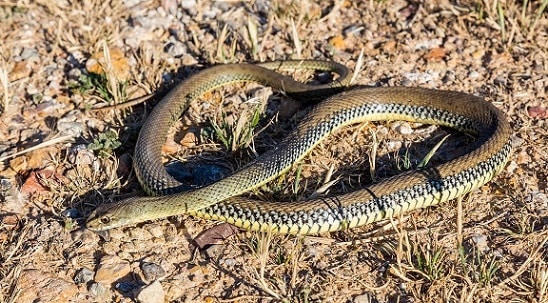
The Montpellier snake is a familiar sight to anyone living in the Spanish or southern French countryside. It’s a holder of two separate records in Spain, the first being the longest snake. Montpellier snakes regularly hit 2 metres, with an all-time record of 2.4 metres, easily long enough to block a narrow footpath and force you to back off. The second record this species holds is being the most common snake in Spain.
The Montpellier snake is extremely unfussy about its habitat, and consequently, its numbers aren’t declining, but actually increasing slightly. They naturally gravitate towards open habitats like scrubland, grassy fields, dunes, marshes, and low growing thickets. But they’re equally comfortable in manmade environments, particularly vineyards, garbage dumps, and wastelands, which they head to in huge numbers in order to feed on rats.
In fact, Montpellier snakes are sometimes more common in manmade environments than natural ones. They even stray into cities, whereas the ladder snake barely enters towns. Montpellier snakes cope well with altitude as well, having been observed at 2180m in the Spanish Sierra Nevada.
| 2 | Venomous, but with a tiny mouth |
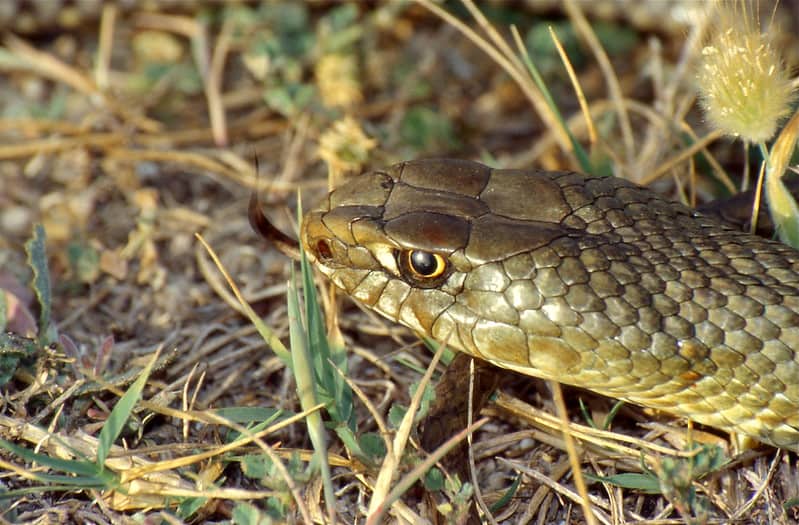
They may control the country, and they may shock people by appearing on stone walls out of nowhere, but the Montpellier snake is far from deadly. It possesses venom, and its fangs are sharp enough to penetrate human skin, but those fangs are located at the back of its jaw. If a Montpellier snake feels like biting, then it must open its jaws extremely wide. Its fangs are also fixed rather than retractable.
Most Montpellier snake bites have been from laughing, overconfident people poking their fingers deep into its mouth for fun. The only reported death was said to have been a Libyan decades ago, and even then, details are sketchy and impossible to track down. Even a big proportion of successful bites are dry bites.
If the venom does wriggle its way in, then the Montpellier snake is firmly in camp neurotoxic. Its venom has the power to paralyse, disconnect muscle control, and trigger random twitching, but the quantities are still way too low. The venom itself is colourless.
| 3 | A classic snake charming species |

The Montpellier snake has a large colony in North Africa, and today, it remains a staple species that snake charmers whip out to dazzle tourists with. The world capital of snake charming is Jmaa el Fna in Marrakesh, where mystical men hold Montpellier snakes between their teeth, or swallow them halfway down their throats, in order to persuade travellers to part with cash.
Snake charming dates back to the 14th century at least, and almost certainly longer. It originated with the brotherhood of Aissawa, who were once starving in a desert, and resorted to eating venomous snakes and scorpions. After miraculously surviving, they were believed to be gifted with snakes ever since.
Charmers of the past would invoke the saint Mohammed ben Aissa and read a Qu’ran verse before starting their shows. A man will typically play a seductive symphony of notes with a flute, to pull viewers into a trance, in unison with the snake show. Charmers often sell pendants to viewers, said to guarantee protection from all snakes. Aside from the Montpellier snake, the much deadlier puff adder is also used.
| 4 | Shines its own scales |
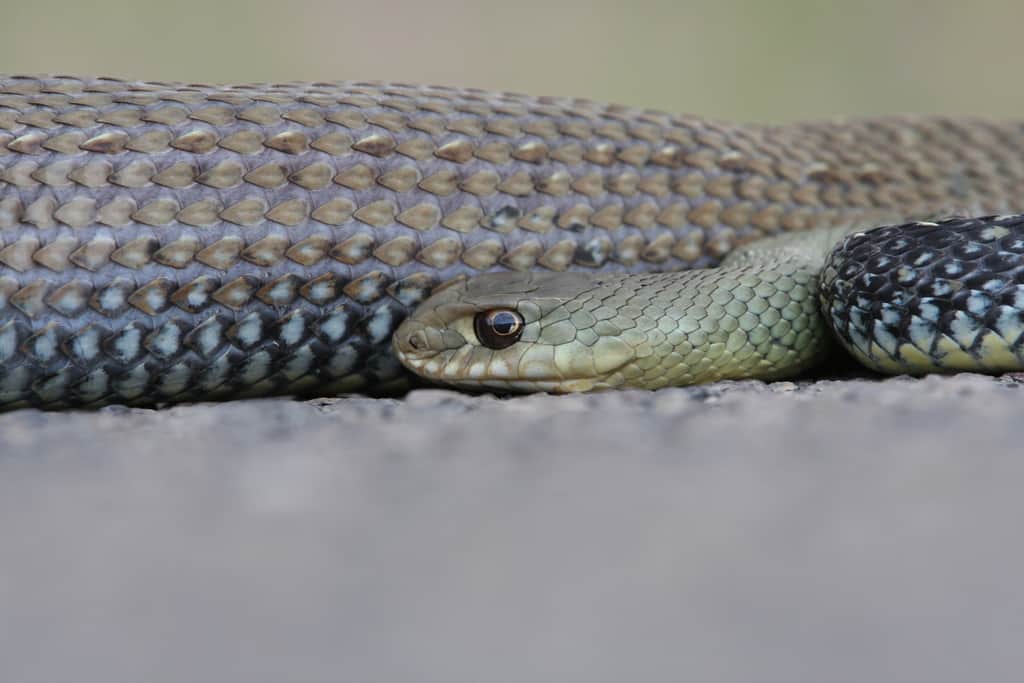
They look fairly ordinary, but Montpellier snakes quietly have one of the rarest snake skills around. The story kicked off in 1898, when scientists noticed the Montpellier snake rubbing its nose area all over its scales, curling up in the way only a snake can (see this video).
Fast forward to 1956, and Soviet scientist Ilya Darevsky discovered a strange gland, located directly above the Montpellier snake’s nostrils. This gland secreted an oily substance consisting of long-chain fatty acids, which acted like polish when rubbed into scales, and noticeably shined them up. Since then, the gland has been found in a few other snakes, but only members of the Psammophiinae sub-family which Montpellier snakes belong to.
To this day, scientists are unsure of the purpose. The main theory is that because the Montpellier snake and its relatives live in arid areas, the waxy polish is designed to prevent dehydration. Backing this up, a 1978 study found that Montpellier snakes lose 10 times less water through their scales than American kingsnakes.
Of course, it’s also possible that Montpellier snakes like having shiny scales.
| 5 | Diet: anything it bumps into |
The Montpellier snake is a master of hydration. It processes water so efficiently that it can skip drinking altogether, and gather moisture solely via swallowing prey. What does its prey consist of? Anything it can find. Unlike the ladder snake of Spain, whose diet consists of 12% birds and 87% mammals, the Montpellier snake is nature’s vacuum cleaner, swallowing down anything it can.
In 2021, a Montpellier snake was even spotted eating a female of its own species. Either it didn’t realise, or it just didn’t care. Unlike striped crayfish snakes, male Montpellier snakes are far bigger than females. Males can reach 2.4 metres, whereas a large female is considered to be 1.4 metres.
That means that males eat larger prey generally, including rabbits, chickens and birds, while females stick to smaller lizards, mice and voles. Overall, Montpellier snakes have a slight bias towards lizards. A study in southwest Iberia (Portugal, southwest Spain) found a diet of 51.2% reptiles, 35.3% mammals, and 13.5% birds.
| 6 | The exact species it eats |
Using the same southwest Spain/Portugal study, the Montpellier snake’s most common meals were…
- Algerian sand racer (Psammodromus algirus) – 20.4% of total prey.
- Oscillated lizard (Timon lepidus) – 10.6%.
- Wood mouse (Apodemus sylvaticus) – 8.2%.
- European rabbit (Oryctolagus cuniculus) – 4.1%.
- Mediterranean pine vole (Microtus duodecimcostatus) – 3.5%.
- Red-legged partridge (Alectoris rufa) – 3.5%.
Montpellier snakes also hunt the smaller ladder snake, which maxes out at 1.4 metres. It’s not all fun and games though, as one study observed a Saharan horned viper biting a Montpellier snake on the head. It died within 5 minutes, and a second snake died within 8 hours. The Saharan horned viper lives in Algeria and Morocco, coexisting with the Montpellier snake colonies there. It measures only 50cm next to 2 metres, yet still dealt out death with ease.
Montpellier snakes are hunted by many birds, swooping overhead, but their single worst predator is the short-toed eagle, a specialised snake hunter. The ladder snake is this killer bird’s favourite, but the Montpellier snake ranks second. Meanwhile, the eagle completely ignores the Riccoli’s snake and false smooth snake, for reasons only they know.
| 7 | Stalks its prey stealthily |
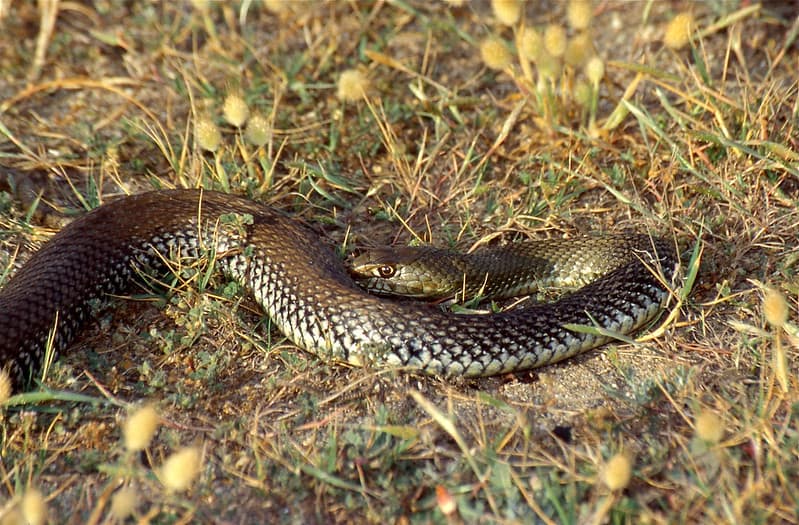
Montpellier snakes are also highly flexible in getting hold of their prey. They’re capable of ambushing, sneaking up, and pursuing at high speeds alike. Prowling stealthily is their favourite though, and in a crop field, a typical hunt involves following a rat through towering columns of wheat, weaving in and out silently.
At the last moment, the Montpellier snake will accelerate through the stalks, before wrapping around its prey using one or two full body coils. The snake will bite the rat simultaneously, opening wide and instinctively angling its mouth to allow the rear fangs to sink in.
Unlike the inland taipan of Australia, Montpellier snakes always hold onto their prey while it slowly succumbs to venom. A typical rat takes 3-5 minutes to perish (which shows how weak the venom is in humans). A viviparous lizard can die as quickly as 90 minutes, while a common wall lizard becomes paralysed in 50 seconds. Montpellier snakes never eat their prey until it becomes fully immobile.
| 8 | Two species (east and west) |
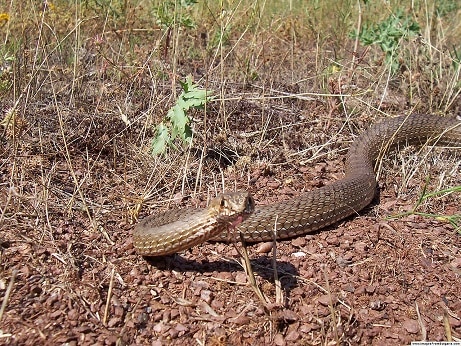
Some biologists believe that the Montpellier snake is actually two separate species – the eastern and western versions. DNA testing proves that those in Spain and those in southeast Europe diverged an estimated 3.5-6 million years ago. Their skulls have subtle differences, with a wider frontal area for the western version and a thinner one further east. The eastern Montpellier snake also has less dark patches.
Montpellier snakes originated in North Africa, and it’s believed that the eastern versions migrated away first, travelling directly along the Mediterranean coastline all those millions of years ago. The Spanish ones separated far more recently, just 80-170,000 years ago, swimming across the Gibraltar strait from Morocco. Consequently, those in the old Moroccan heartlands have very similar DNA to those in Spain, despite a literal gulf between them.
Meanwhile, a new western subspecies was discovered in 2006, called M. m. saharatlanticus. This is the most isolated subspecies, hiding in the arid outpost of West Sahara, hugging the Atlantic coastline. This version has the most black patches of the four.
| 9 | Paranoid males |
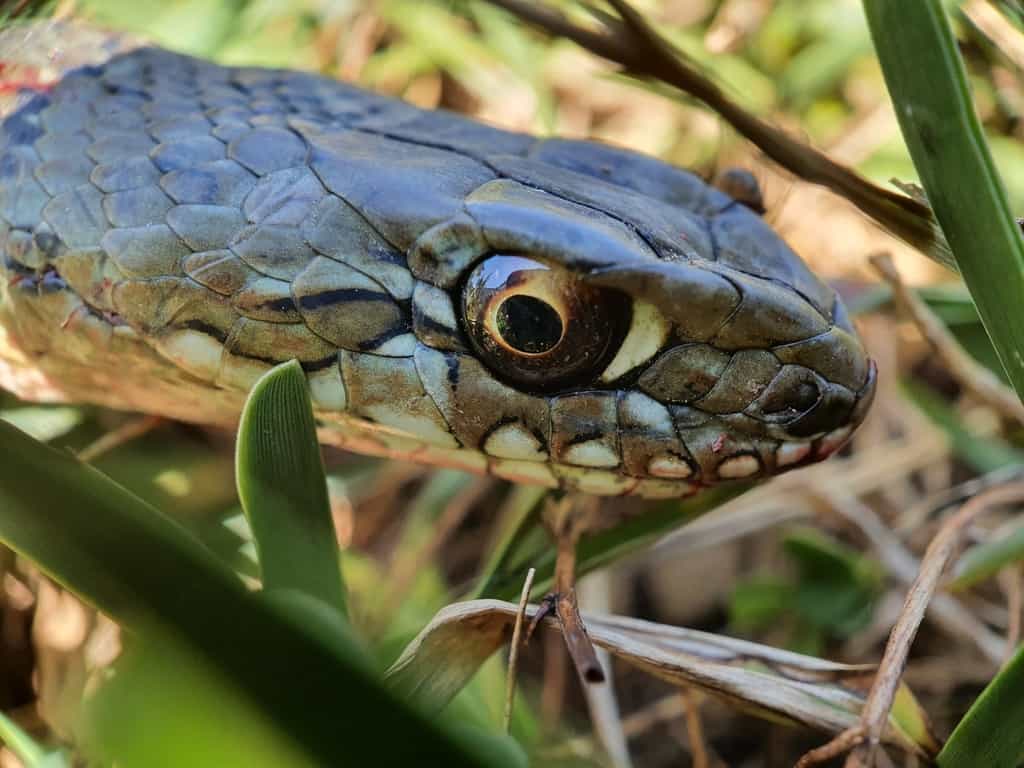
Breeding season is early June for the Montpellier snake. This means that early June is also peak season for male on male fighting. While mating, male Montpellier snakes barely relax – they’re always scanning the horizon with an eagle eye, watching for rival males attempting to slither up and shove them aside.
As for females, they lay their eggs extremely quickly, sometimes just 19 days later. In the days before giving birth, female Montpellier snakes become extremely active. They’ll slither all over the place, in and out of rabbit burrows, up and down, forwards and backwards, racing around the countryside looking for the ultimate egg den at the last minute. The usual number is 3-11, with a maximum in captivity of 14. Montpellier snake eggs are white, and have a leathery, parchment-like texture. The shells look furrowed on the surface, and are quite thick for a snake egg.
Despite laying relatively few eggs, 68 have been found together in one nesting spot. This is because Montpellier snakes practise communal nesting – seeing eggs in a spot, and assuming with their instinctive reptile brain that it’s safe for their eggs as well.
| 10 | Detects humans from 40 metres away |
As youths, Montpellier snakes rely on camouflage for their defence. They stay still and hope that their relative non-flashiness helps them to blend in with fields or low-lying thickets.
As they grow, they discover a new weapon – speed. Montpellier snakes are very agile, and can zip up a crumbling stone wall and down the other side in a split second. They can also leap into water and swim away relatively quickly, wriggling back and forth to accelerate like a speedboat.
If they choose to stand their ground, then they don’t waste time hissing – the Montpellier snake’s noise of choice is a loud snort. They can also shift bones in their skull to triangulate their head, with the goal of mimicking a viper.
Another impressive ability is recognising human beings from 30-40 metres away, a rare feat for snakes and their notoriously feeble eyesight (note that bears do have good eyesight). In fact, Montpellier snake eyesight is above average generally – alongside the golden tree snake, their eyes have a special UV resistant lens.
